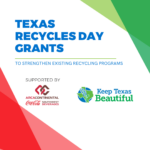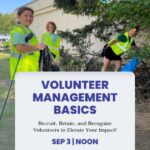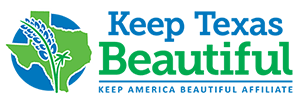Trash Free Waters Projects
Reduction and Prevention of Trash in Texas and the Gulf of Mexico Watershed
In September of 2020, Keep Texas Beautiful (KTB) was awarded over $400,000 through an EPA Trash Free Waters grant. KTB leveraged partners from its existing affiliate network and chose three unique Texas communities in the Gulf of Mexico watershed to provide funding and technical assistance to create benchmark programs for litter cleanup and prevention that can be shared throughout Texas and beyond. These projects promote education, infrastructure and cleanup activities with an end goal of reducing litter and its eventual flow into the Gulf of Mexico.
Short-range Goals:
- Litter diverted from flowing downstream by capture devices.
- Litter cleaned by enhancing current litter cleanup activities.
- Increased reporting of litter issues in Galveston Bay.
Long-range Goals:
- Cleaner beaches, parks, roads, and waterways with less visible litter.
- Reduction of the amount of litter collected and cleanups needed.
- Increased community resiliency through stronger local partnerships.
- Strong litter prevention programs verified and shared with other communities for replication.
Projects

Rio Grande Valley
McAllen is located near the border in the Rio Grande Valley and all waterways in the area flow down to the Gulf of Mexico. KTB, Keep McAllen Beautiful and the City of McAllen partnered to invest in various trash-capture devices to prevent flow downstream, including a boom system, a netting capture system and sewer inlet covers along their busy downtown district.
Read More
Keep McAllen Beautiful also invested in BigBelly trash units to help increase trash capacity and keep it off the streets.

Central Texas Region
San Marcos is home to the San Marcos River. This river is spring fed and features endangered flora and fauna like Texas wild rice, Texas blind salamanders, San Marcos gambusias, and fountain darters. KTB partnered with Keep San Marcos Beautiful to accomplish a variety of activities including creating an educational mural near their busiest recreation entrance.
Read More
This mural depicts two of the endangered fauna as cute cartoon characters and encourages visitors, “For the love of the river, pick up your litter!” These characters will also be featured in a youth education and activity book currently in production. Other San Marcos projects include a gabion wall constructed behind a busy truck stop that was polluting one of their major feeder creeks and conducting various hot spot cleanups and litter audits throughout their community. They also partnered with the local university, Texas State University, to spread more awareness and increase litter and recycling programs on campus.

Houston-Galveston Region
In the Houston-Galveston region KTB lead projects concentrated on the bayou system throughout the city. We partnered with Buffalo Bayou Partnership to install boom systems to capture and divert trash flowing through the area. These materials were then vacuumed up by a specialized vessel run by the Partnership.
Read More
Litter collected from this and other methods throughout the region was audited and studied by Black Cat GIS to create a methodology that will be shared with peers and students throughout Texas. KTB also partnered with the Galveston Bay Foundation to improve and promote the Galveston Bay Action Network (GBAN). GBAN (www.galvbay.org) allows citizens to report litter hot spots, abandoned vessels and traps, illegal dumping and other pollution in the four counties that surround Galveston Bay. Through a questionnaire, reports are automatically sent to the appropriate agency for cleanup and action. Improvements will help make the site more user friendly and promotion will spread the word to increase citizen awareness and usage of the site. This will, in turn, help increase citizen action taken to clean up the bay and keep it beautiful!
All Regions
KTB provided free waterway cleanup supplies to groups in all three regions. These included items such as gloves, sunscreen, litter pick up tools and mesh bags branded with Trash Free Waters education and mention that they were provided by funding received from an EPA Trash Free Waters grant. In return, these groups provided valuable data such as location cleaned, amount of trash collected and types of trash determined through auditing activities.
2022 Impact
Trash Free Waters Projects
36
Cleanup Events
37,358
Pounds of Litter Removed
1,158
Volunteers
9,000
Pounds of Litter Diverted



